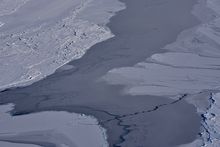Tracking openings in sea ice of the Arctic and Antarctic Ocean

The Arctic and Antarctic oceans are located in areas that are experiencing new conditions due to climate change (higher atmospheric temperatures, melting of ice sheets). Nevertheless, it is difficult to understand the changes in sea level, due to the fact that large areas are seasonally or permanently covered by sea ice. Scientists at DGFI-TUM have developed a new technique to spot the leads, i.e. openings in sea ice that uncover the sea surface, by analysing the data of ESA's successful Cryosat-2 mission.
The radar altimeter on board sends electromagnetic waves and collects the reflections from the ocean surface at different incidence angles. But the retrieval of meaningful sea level estimates requires not only the recognition of the leads. It also needs to be ensured that the openings are perpendicular to the satellite position (nadir position).

As the sea is calm and flat, the leads act like a mirror for the satellite: they could be easy to recognise, but their reflection is so strong that it has a signature on the data also at other incidence angles. An undetected lead is a missed opportunity to measure sea level, but a lead detected when not at nadir can cause a wrong estimation.
By tracking the signature that the leads leave on the collected data, it is possible to improve the detection capabilities. This is shown in the publication Lead Detection using Cryosat-2 Delay-Doppler Processing and Sentinel-1 SAR images (Advances in Space Research, 2017, DOI: 10.1016/j.asr.2017.07.011, [PDF]). The technique is also validated using radar images from Sentinel-1 (see picture above). This study will increase the reliability of the sea level analysis at high latitudes and thus contributes to improve the knowledge of the sea level dynamics in the Arctic and Antarctic oceans.
Arcisstraße 21
80333 München